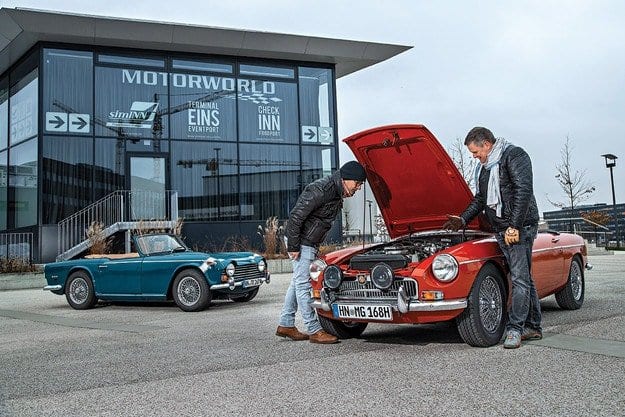
Test drive MGC and Triumph TR250: six cars

Two British roadsters for fun in nature
Those interested in a compact British roadster with an inline-six in 1968 found what they were looking for. MG and Triumph. Famous for their traditions, brands almost simultaneously represent MGC and especially for the American market Triumph TR250. Which of the two cars is more exciting?
God, what a bike! The massive six-cylinder unit is so tightly packed between the cooling fan and the cab wall that it's hard to insert a simple 7/16 wrench on either side. On the right are two solid SU carburetors that someone might have gotten from a Jaguar XK 150. In order to fully close the hood over the MGC engine, it is given a wide bulge, reminiscent of the chest circumference of Arnold Schwarzenegger in the movie Conan the Barbarian. So there is no doubt: MGC is a real oil machine.
Following the American model, MG transplants the three-liter six-cylinder engine with 147 hp, developed for the Austin 3-Liter sedan, into a small, initially weighing only 920 kg MGB. As a result, compared to the 1,8-liter four-cylinder version, power is increased by 51 hp. - that is, more than doubled. And for the first time, a production MG breaks the 200 km/h milestone. MG considers such a radical increase in power absolutely necessary for two reasons: firstly, almost simultaneously with this, main competitor Triumph launches the TR5 PI with a 2,5-liter six-cylinder engine with 152 hp. With. Second, MG is hoping the six-cylinder roadster can offer a replacement for the discontinued Austin-Healey.
How new is MGC?
The fact that MG wanted to lure Healy's former clients with MGC probably explains the slightly grandiose name that, after MGA and MGB, actually promises a completely new car. MG marketers believe that when they call it MGB Six or MGB 3000, the proximity to a small and inexpensive four-cylinder model will be immediately noticeable. However, MGC will make a clear distinction from the MGB (which is still in production), signaling that a completely different, significantly sportier convertible is on offer.
One way or another, a lot has really changed under the hood - not only the engine is completely new, but also the front suspension. The body bulkhead, side walls and front sheet metal also had to be modified to fit the 270kg six-cylinder monster in the engine bay of the compact, less than four meter long MGB. However, as a result, the pressure on the front axle increased by almost 150 kg. Do you feel it while driving?
At least the editors of British Autocar magazine in November 1967 were not very happy when they put the MGC to the test. Firstly, the steering, despite the indirect transmission, has a rather difficult stroke during parking maneuvers. Combined with the added weight on the front axle due to MGC's understeer, it lacked the "lightness of an MGB or Austin-Healey". Conclusion: "It is better to move on large highways than on narrow mountain roads."
But now it's our turn. Fortunately, the classic car dealer Holger Bockenmühl provided us with a red MGC for the ride. The Bockenmühl room with interesting classic models is located just behind the Motorworld complex in Boeblingen, where this MG is sold (www.bockemuehl-classic-cars.de). There we also expect Frank Elseser and his Triumph TR250, whom we invited for this roadster comparison. Both convertibles were released in 1968.
The TR250 is the American version of the TR5 PI and has two Stromberg carburetors instead of a petrol injection system. The power of the 2,5-liter six-cylinder engine is 104 hp. - But the Triumph model weighs a hundred kilograms less than the MG representative. Does that make it smarter than two roadsters? Or the missing 43 hp. obscure driving pleasure?
First of all, it should be noted that the red MGC has undergone some modifications and has interesting additions: additional headlights and controls, a tripmaster, seats with rear supports, an additional installed electric steering wheel, tires 185/70 HR 15, roll-over bars and belts as an optional accessory. As usual with the original MGB, the long doors allow for a comfortable ride in the low convertible. Here, you sit up straight and stare at five small but easy-to-read Smiths devices with delightfully stern and angular numbers that give the speedometer a top speed of 140 miles per hour (mph), or 225 km / h.
Consisting of black plastic covered with thick padding in front of the passenger next to the driver and a protected instrument panel right in front of the person sitting at the wheel, two ball-shaped rotary heating controls and a fan are installed. At a temperature of about eight degrees outside, we will set both maximum values. But first, a six-cylinder engine with a large displacement must warm up well. The cooling system contains 10,5 liters of liquid, so this will take time. But it's quite pleasant - even at less than 2000 rpm, we upshift with a crisply working four-speed gearbox, and the roughly strong six propels the lightweight convertible effortlessly from low revs.
If we want to overtake someone with a hot car, we double the shift speed to a maximum of 4000 - and that's more than enough. In case the mild-mannered MGB wants to be on par with us, its often confident four-cylinder engine, like jazz legend Dizzy Gillespie, would puff out its cheeks. That largely ambitious PTO in the MGC almost feels like a Jaguar E-Type - though at higher revs, Austin's six-cylinder loosens its grip and runs a little more unevenly. The clunkiness of the MGC mentioned by former testers when turning the steering wheel or in tight corners is almost not felt, probably thanks to the electric power steering and wide 185 tires.
Intimate cramped triumph
The direct transition from MGC to TR250 acts like a trip back in time in a time machine. The body of the TR250, which is slightly different from the TR1961 introduced in Year 4, is five centimeters narrower than the MGB body, but the same length. However, the space behind the slightly smaller steering wheel is much less. Here the good news is that when moving down with the guru, you can rest your hand on the upper edge of the door. On the other hand, the Triumph spoils its pilot with larger controls that, while built into the beautiful wood dashboard, do not feature chrome bracelets.
The 2,5-liter six-cylinder engine, which looks significantly smaller, impresses above all with its silky, quiet and smooth operation. With a long stroke of 95 millimeters, the sixth Triumph is about six millimeters superior to the larger-displacement MGC Austin. As a result, the Triumph's bore is about a centimeter smaller than the MG beast - and the TR250's smooth-running six pistons are thinner and thinner accordingly.
With a shorter gear lever travel, slightly lighter vehicle weight and a deeper ride, the Triumph delivers a sportier ride than the MGC. Here you feel like a real roadster, which behaves a little more friendly to its driver than the impressive MGC with its powerful engine. On well-groomed, unrestricted trails, the powerful MG is sure to pull away from the sleek Triumph, but on narrow mountain roads with curves, you can expect a dead end situation where the Triumph driver's hands remain dry.
Despite these differences, the two models share a common destiny - they do not have much commercial success, which, by the way, Triumph did not plan at all. The TR5 PI and its American version TR250 were followed just two years later by the debut of the TR6 with a completely new body. The fact that the TR5 and TR6 are available in two different versions is due to more stringent emissions regulations in the United States. Triumph connoisseurs, such as brand book author Bill Pigot, suggest that the company wanted to rescue buyers in the US from the still under-tested and difficult-to-maintain injection systems of the PI (Petrol Injection) model.
The MGC was also in production for only two years (1967-1969) and never came close to the successful sales of the legendary Austin-Healey. Both roadsters, despite their overtly authentic character, are harbingers of the decline of the British car industry. Their period of production coincided with the founding of British Leyland in 1968, a great industrial tragedy over brands, responsibilities and strategies.
Conclusion
Editor Franc-Peter Hudek: The MGC and Triumph TR250 offer decent power from the low revs of their vintage six-cylinder engines to tried and tested simple technology and impressive outdoor driving pleasure. However, the tragedy of mismarketing with correspondingly few units produced turns them into underdogs that are still listed relatively cheaply - a fortune for true connoisseurs.
Text: Frank-Peter Hudek
Photo: Arturo Rivas
HISTORY
British Leyland and the beginning of the end
FOUNDATION British Leyland in 1968 was the culmination of a long wave of mergers for British car manufacturers. The merger of about 20 auto brands was supposed to simplify production by co-developing and using as many identical parts as possible, while helping to create attractive new models. The most important brands are Austin, Daimler, MG, Morris, Jaguar, Rover and Triumph. The name Leyland comes from a truck manufacturer that acquired Standard-Triumph in 1961 and Rover in 1967.
However, the grand merger ended in fiasco. The problem is too broad and difficult to deal with. In addition to having numerous divisions in its prime, British Leyland has over 40 car factories spread across Central England. Disputes between management, large misinvestments and poor product quality - partly due to strikes after the closing of factories - led to a rapid decline in the industrial group. At the end of 1974, the concern was on the verge of bankruptcy. After nationalization in the 80s, it was fragmented.
In the gallery, we show four typical British Leyland models as examples of inappropriate modeling policies, outdated technology and misconceptions about the international market.
